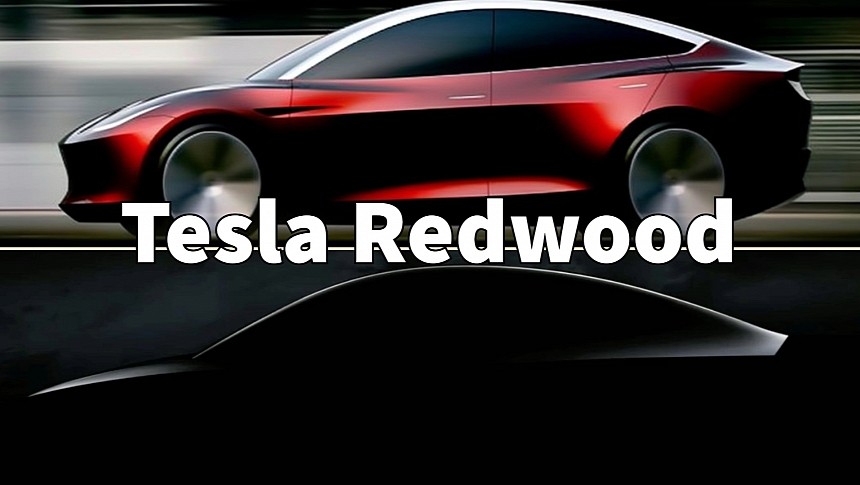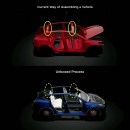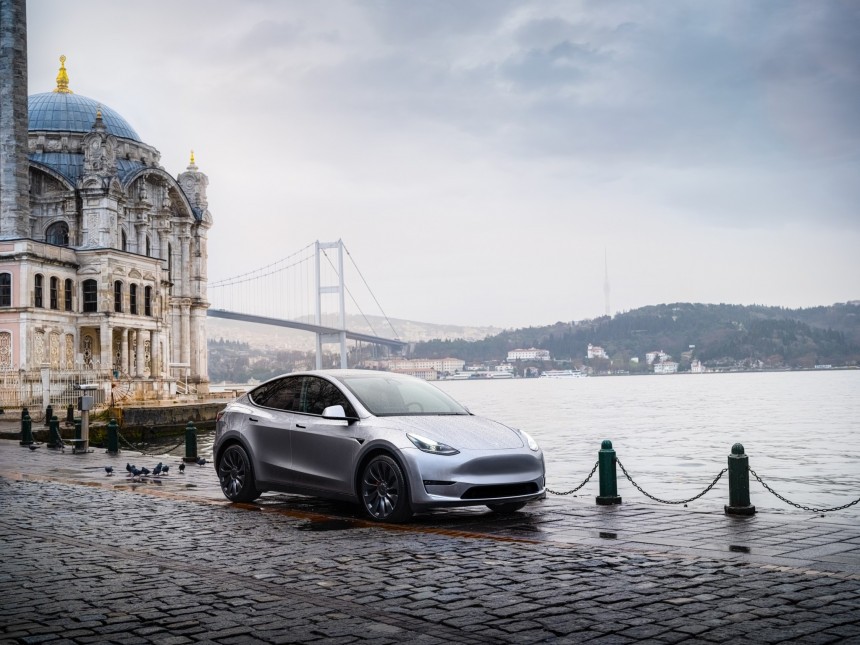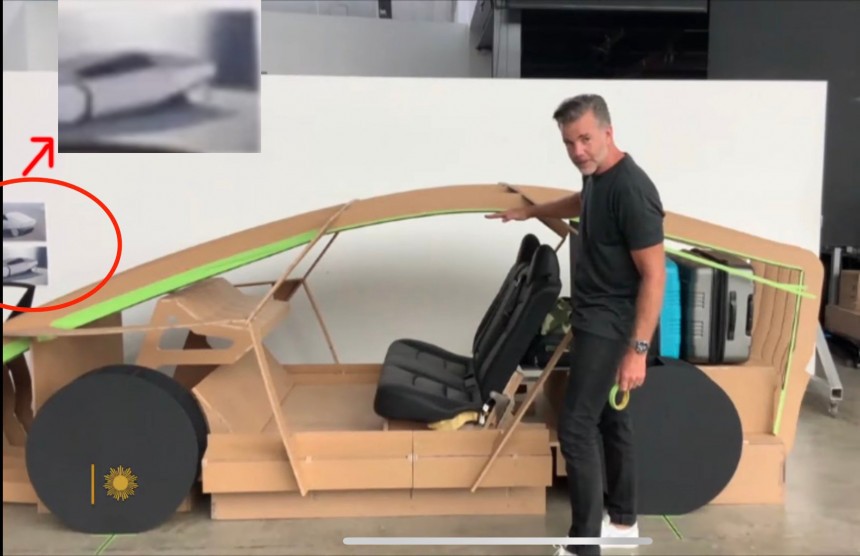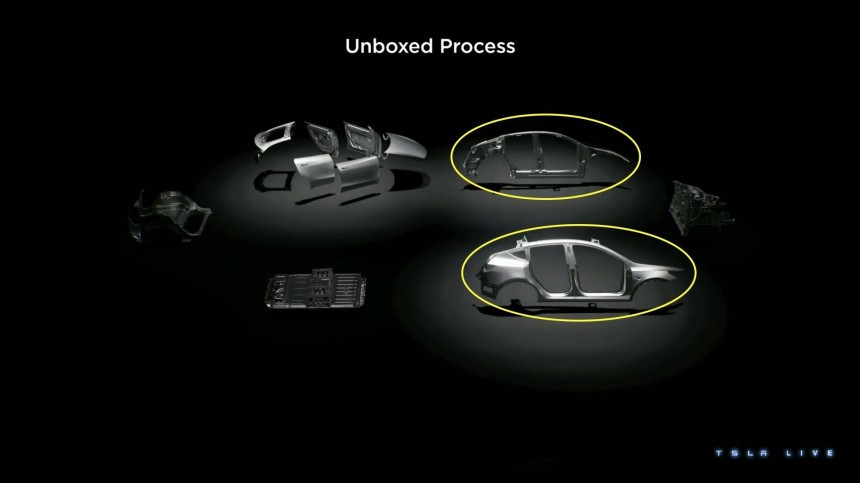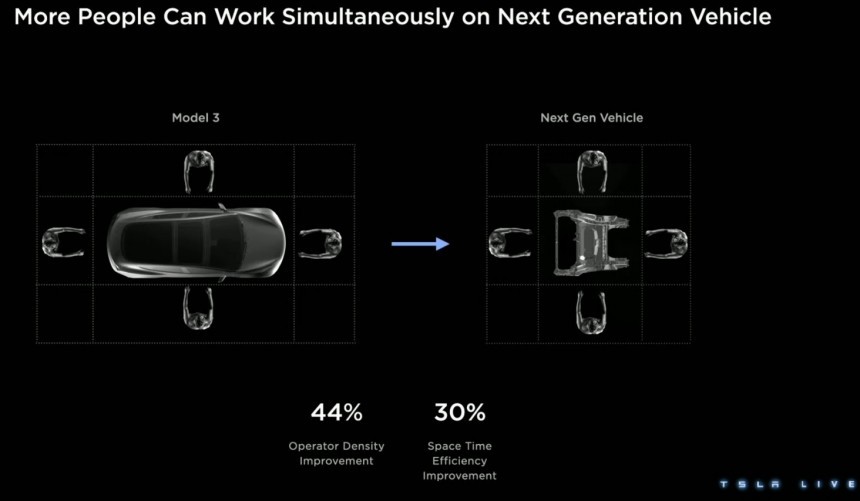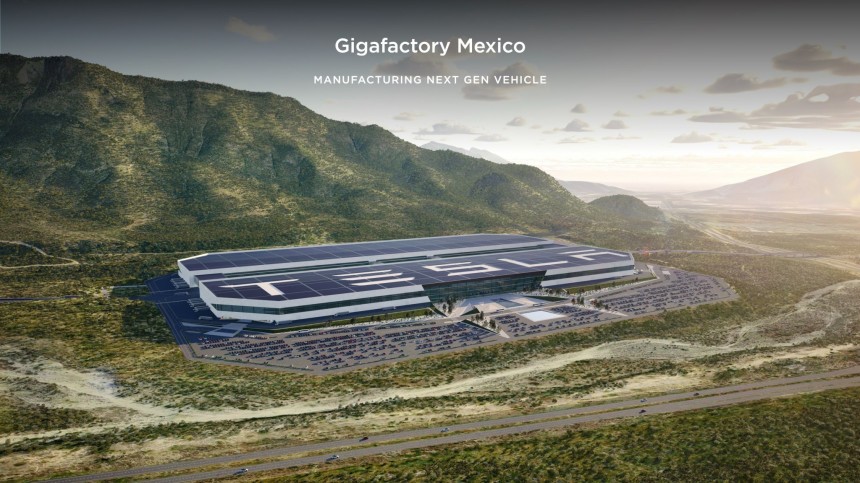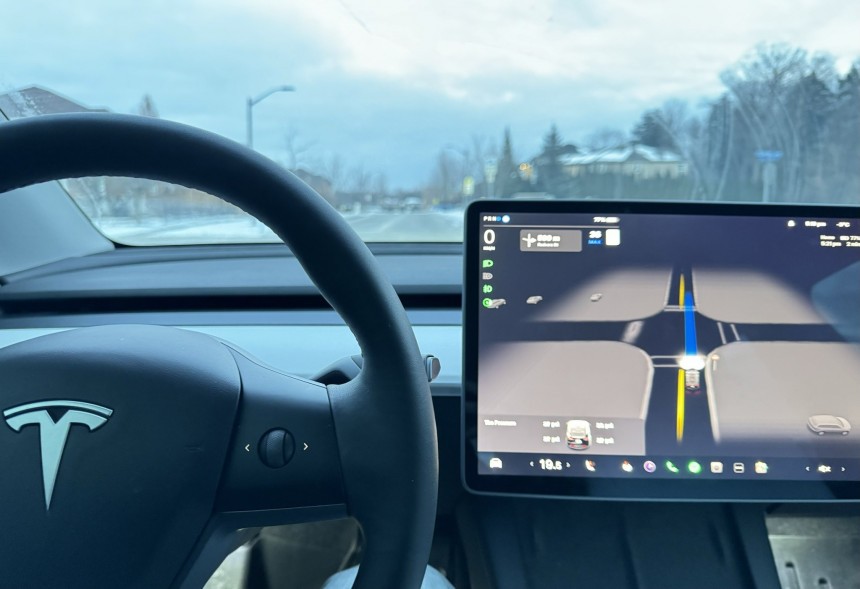Tesla confirmed that its Gen-3 platform underpinning next-generation EVs should be ready next year. The EV maker will build at least two models based on this architecture, and the first will be a compact EV codenamed Redwood, which will become Tesla's most affordable EV. Here's everything you should know about Tesla Redwood.
Tesla has been playing with the idea of producing an affordable electric vehicle that everyone could buy for a long time. In fact, this idea is at the foundation of Tesla's mission. After all, you cannot replace all cars on Earth with EVs if only a few people can afford them. Still, Tesla had to take many things into account, making the dream of an affordable EV remain just a dream until now.
On the one hand, economics prevented Tesla from lowering its EV prices. Selling cheap EVs made little sense as long as you could not produce enough to flood the market. In fact, until 2022, demand was so high that Tesla could've doubled the prices and still sell its cars like hotcakes. Every carmaker and dealer in the US got away with doing just that.
On the other hand, producing electric vehicles at scale requires more resilient supply chains. This was, in fact, the main problem that led to the violent disparity between demand and supply. During the pandemic, people postponed their car purchases, and the auto industry ground to a halt. This caused many suppliers to go out of business, while the most resilient found other customers. When things rebooted in 2021, carmakers found out that their supply chains were no longer there, and they had to compete with other industries that fared better.
This is why Elon Musk seemed to have abandoned the $25,000 EV plans at the time. However, as the demand evaporated toward the end of 2022, finding new growth centers became more important. The current lineup could only take Tesla so far, and that was with the help of massive price cuts in 2023. It worked, and Tesla could fulfill its promises, but at the expense of automotive margins, which shrank significantly.
The Tesla Model Y became the best-selling car in the world in 2023, as predicted, having sold more than 1.2 million units. Still, it's clear now that the Model Y won't be enough to keep Tesla growing even with the makeover known as Project Juniper. Elon Musk admitted as much, saying that Tesla is now "between two major growth phases." The first was generated by the Model Y's success, but the second can only happen when Tesla launches its next-generation EVs.
Musk has a brilliant mind, but it sometimes functions in a less obvious way. If we take what Walter Isaacson wrote in his book for granted, Musk had to be persuaded to jumpstart the affordable EV project. He only agreed to do it when he was told that the robotaxi project Musk loved so much was dead in the water without the economy of scale afforded by the compact EV's volumes. Thankfully, the "intervention" was successful, and Musk announced the next-generation EVs during Investor Day in March 2023.
It was clear by then that Tesla had enough time to work on the project that it came up with the idea of an entirely new manufacturing process. This required a new type of gigafactory, which is why Tesla also announced Giga Mexico as the production venue for the new model. The compact EV project, now known as "Redwood," started to look possible. However, Tesla has to pull all the strings to turn it into a success story.
And yet, Walter Isaacson's book about Elon Musk contains a sketch of a weird two-door compact that could be the robotaxi Tesla plans on the same Gen-3 platform as the $25,000 EV. To add salt and pepper to this picture, we also have Tesla's chief designer, Franz von Holzhausen, in front of a wooden mockup. It's weirdly shaped and, although it makes sense as a driverless robotaxi, is less compelling as a personal vehicle.
Although crossovers are not as efficient as sedans, they are the most popular form factor nowadays, and their appeal is universal. There's no market in the world where crossovers are a tough sell, which is why I believe Tesla will design the next-generation compact as a crossover. In fact, earlier rumors coming from Tesla's Chinese suppliers indicated that the "Redwood" EV would look like a smaller Model Y. This makes sense, although not entirely.
Tesla Model Y's design is already long in the tooth, and the Model 3 refresh makes it even clearer. Sure, Tesla would streamline the details and keep the overall shape that has already been honed for aerodynamic efficiency. This variant is supported by the silhouette Tesla revealed during the Shareholder Meeting in May 2023.
And yet, Elon Musk spoke very enthusiastically about the new model's design, which makes me believe this could be more than a shrunk Model Y. Another piece of information from Isaacson's book offers more context. Based on this, Musk saw the models of both the robotaxi and the compact EV side by side, and they both had a "futuristic design." That's definitely not how I'd describe the Model Y. "When one of these comes around a corner," Musk is quoted as saying, "people will think they are seeing something from the future." That's more like a Cybertruck-like design than Model Y.
An automaker could save billions in manufacturing costs by standardizing parts and even entire vehicle sections. This was especially true for big companies with dozens of models. Volkswagen launched the MLB architecture with the Audi A5 in 2007 and the MQB architecture with the Golf VII in 2012. Those two architectures would cover all the models with longitudinal engines (MLB) and transversal engines (MQB) across many modes and brands in Volkswagen's extensive portfolio. Soon, the trend caught up, and the entire auto industry switched to modular architectures.
Tesla doesn't yet have a lot of models to benefit from a modular architecture, but that doesn't mean it didn't innovate car manufacturing. The first-generation platform underpinning the Model S and Model X was a classic skateboard construction, with the battery between the axles. However, this was still based on what the auto industry's best practices were at the time when the Model S started development in 2007. Tesla would change that with its Gen-2 platform underpinning the Model 3 and Model Y.
Tesla's Gen-2 is not a modular architecture per se, but it's much more than that regarding the potential to cut costs. Tesla innovated a lot on this front, so the production costs of the Model Y and Model 3 are roughly half those of the Model S/X. Tesla optimized this architecture by introducing megacastings, among other things. These are large structures that replace hundreds of parts that previously needed to be stamped and welded. Also, using the battery pack as a structural element, the EV maker saved a lot on unnecessary structures.
With the next-generation EVs, Tesla goes even further and, for the first time, makes the Gen-3 architecture truly modular. The goal is to be able to build different kinds of vehicles, even different sizes, using the same architecture. It would also make localized versions of the same models possible without changing anything besides the design. But the most important innovation is cutting the car into several sections and building them simultaneously.
This is why the Gen-3 architecture is optimized for this, and a lot is borrowed from Cybertruck's design. Because it's difficult to have this new architecture function with classic wire harnesses and brake lines, everything will be electronically controlled. In the Cybertruck, different subassemblies have their own communication and control computers, and all are connected via a Gigabit Ethernet connection that Tesla calls "Etherloop."
A recent patent shows that Tesla also intends to integrate the power lines and communications in every component so that few wires (or none at all) are needed to connect everything. To make this work at scale, Tesla will have to use the 48-volt architecture, steer by wire, brake by wire, and other technologies it is working on behind the scenes. Some of them are already in customer testing with the Cybertruck. Tesla only needs to make them cheaper and scale production to the extreme.
In traditional manufacturing, cars are made by stamping the body parts, assembling them for painting, removing the doors to install internal components, and then re-adding the doors in the final assembly. The unboxed-vehicle process divides manufacturing into several critical workflows. Stamped parts, like the body sides and the car floor, are processed in one workflow. Another stream takes care of casting the front, rear, and possibly other parts.
The production time is significantly reduced because different teams can work on different tasks simultaneously. Also, the internal components like seats and dashboards are already installed in their corresponding sections. When these are complete on their related production lines, they are put together like Lego bricks, and only minimal work is needed to install the final trims and components.
Many steps in the manufacturing process can be eliminated, and this goes for individual components, too. There are no wires, no wasted time, and no lengthy final assembly line. This makes Tesla confident it can reduce costs by 50% compared to Model Y and Model 3. The unboxed vehicle process is crucial for making the Redwood EVs profitable at the $25,000 price point. If Tesla succeeds, it's game over for other carmakers already struggling at the current $40K level.
As Elon Musk would say, the best part is no part, and this is the underlying principle of Tesla's gigafactories. Instead of building warehouses to store parts and components, Tesla unloads the components directly on the production line when and where they are needed. Tesla calls this "Warehouse on Wheels," and it works miracles for manufacturing efficiency. Another component is the high level of vertical integration. Almost everything is produced near the gigafactory to optimize logistics.
However efficient this might seem, producing the Gen-3 architecture vehicles will not work with Tesla's current gigafactories. Despite the many groundbreaking innovations in manufacturing, they are not the perfect fit for the unboxed-vehicle manufacturing process. That's why Tesla is working on a new factory layout that will wow everyone when unveiled. The first factory to use it was supposed to be Giga Mexico, but plans have changed. Tesla will start the unboxed vehicle production at Giga Texas instead and only later expand it to other gigafactories.
The new type of gigafactory will have an even smaller footprint, reduced by about 40% compared to existing facilities. This is logical, considering that many steps in the assembly process are no longer necessary. The new gigafactory layout will also improve operator density by 44% and space-time efficiency by 30%.
There are two possibilities based on whether Tesla will crack autonomous driving before launching next-generation vehicles. If it does, Musk said the value of FSD would increase exponentially. Even at the current price of $12,000, it accounts for half the price of a Redwood EV, so nobody will even consider paying for it if it's more. On the other hand, if FSD is working, Tesla will not want to sell it in the first place. Instead, it would be more profitable to rent driverless cars or provide services to the public. After all, this is what the whole robotaxi idea is about.
If the FSD remains a Beta, fringe technology, Tesla will not be able to sell it with Redwood for the same reason above: it's too expensive compared to the price of the vehicle. It would also want to have as many beta testers as possible on the road to speed up development, and this can be achieved by offering FSD free of charge or for a modest extra. As you can see, there's not a lot of overlap between the next-gen vehicles and FSD. It's either no Redwood and all robotaxi, or all Redwood and no robotaxi.
In the first case, talking about Redwood's technologies is superfluous because Tesla will offer this on a Cars-as-a-Service basis. People couldn't care less what makes it tick as long as it works. Scaling production to the extreme will be less critical for the general public. It will be all in Tesla's hands, and even the price won't matter to you and me.
On the other hand, without the FSD fully functional, Tesla would want to play the volume part all the way. Making it profitable will become crucial since there will not be a significant revenue stream from the self-driving services. My guess is that this will be the most probable outcome, at least in the first years of production. Scaling production and expanding globally would take time, so things could significantly change by the time Redwood EVs are mass-produced.
On the one hand, economics prevented Tesla from lowering its EV prices. Selling cheap EVs made little sense as long as you could not produce enough to flood the market. In fact, until 2022, demand was so high that Tesla could've doubled the prices and still sell its cars like hotcakes. Every carmaker and dealer in the US got away with doing just that.
On the other hand, producing electric vehicles at scale requires more resilient supply chains. This was, in fact, the main problem that led to the violent disparity between demand and supply. During the pandemic, people postponed their car purchases, and the auto industry ground to a halt. This caused many suppliers to go out of business, while the most resilient found other customers. When things rebooted in 2021, carmakers found out that their supply chains were no longer there, and they had to compete with other industries that fared better.
This is why Elon Musk seemed to have abandoned the $25,000 EV plans at the time. However, as the demand evaporated toward the end of 2022, finding new growth centers became more important. The current lineup could only take Tesla so far, and that was with the help of massive price cuts in 2023. It worked, and Tesla could fulfill its promises, but at the expense of automotive margins, which shrank significantly.
Musk has a brilliant mind, but it sometimes functions in a less obvious way. If we take what Walter Isaacson wrote in his book for granted, Musk had to be persuaded to jumpstart the affordable EV project. He only agreed to do it when he was told that the robotaxi project Musk loved so much was dead in the water without the economy of scale afforded by the compact EV's volumes. Thankfully, the "intervention" was successful, and Musk announced the next-generation EVs during Investor Day in March 2023.
It was clear by then that Tesla had enough time to work on the project that it came up with the idea of an entirely new manufacturing process. This required a new type of gigafactory, which is why Tesla also announced Giga Mexico as the production venue for the new model. The compact EV project, now known as "Redwood," started to look possible. However, Tesla has to pull all the strings to turn it into a success story.
1. The design: A smaller Model Y?
Much has been discussed about what the upcoming affordable EV might look like. Many renderings show a compact hatchback, a form factor that was very popular in Europe but not so much in other markets. Considering Tesla's plans to scale production to the extremes, this would not make much sense. Even in Europe, compact hatchbacks lost their shine years ago, being surpassed by small crossovers.And yet, Walter Isaacson's book about Elon Musk contains a sketch of a weird two-door compact that could be the robotaxi Tesla plans on the same Gen-3 platform as the $25,000 EV. To add salt and pepper to this picture, we also have Tesla's chief designer, Franz von Holzhausen, in front of a wooden mockup. It's weirdly shaped and, although it makes sense as a driverless robotaxi, is less compelling as a personal vehicle.
Tesla Model Y's design is already long in the tooth, and the Model 3 refresh makes it even clearer. Sure, Tesla would streamline the details and keep the overall shape that has already been honed for aerodynamic efficiency. This variant is supported by the silhouette Tesla revealed during the Shareholder Meeting in May 2023.
And yet, Elon Musk spoke very enthusiastically about the new model's design, which makes me believe this could be more than a shrunk Model Y. Another piece of information from Isaacson's book offers more context. Based on this, Musk saw the models of both the robotaxi and the compact EV side by side, and they both had a "futuristic design." That's definitely not how I'd describe the Model Y. "When one of these comes around a corner," Musk is quoted as saying, "people will think they are seeing something from the future." That's more like a Cybertruck-like design than Model Y.
2. The architecture: Head and shoulder above anything else in the industry
When Tesla was considered a startup doomed to fail, Toyota was the automotive industry's darling. The innovations Toyota introduced to car manufacturing brought the auto industry to the insane scale it has today. And yet, another company reinvented automotive architecture: Volkswagen. The German carmaker was among the first to understand that cars were becoming too complex for their own good.An automaker could save billions in manufacturing costs by standardizing parts and even entire vehicle sections. This was especially true for big companies with dozens of models. Volkswagen launched the MLB architecture with the Audi A5 in 2007 and the MQB architecture with the Golf VII in 2012. Those two architectures would cover all the models with longitudinal engines (MLB) and transversal engines (MQB) across many modes and brands in Volkswagen's extensive portfolio. Soon, the trend caught up, and the entire auto industry switched to modular architectures.
Tesla doesn't yet have a lot of models to benefit from a modular architecture, but that doesn't mean it didn't innovate car manufacturing. The first-generation platform underpinning the Model S and Model X was a classic skateboard construction, with the battery between the axles. However, this was still based on what the auto industry's best practices were at the time when the Model S started development in 2007. Tesla would change that with its Gen-2 platform underpinning the Model 3 and Model Y.
Tesla's Gen-2 is not a modular architecture per se, but it's much more than that regarding the potential to cut costs. Tesla innovated a lot on this front, so the production costs of the Model Y and Model 3 are roughly half those of the Model S/X. Tesla optimized this architecture by introducing megacastings, among other things. These are large structures that replace hundreds of parts that previously needed to be stamped and welded. Also, using the battery pack as a structural element, the EV maker saved a lot on unnecessary structures.
This is why the Gen-3 architecture is optimized for this, and a lot is borrowed from Cybertruck's design. Because it's difficult to have this new architecture function with classic wire harnesses and brake lines, everything will be electronically controlled. In the Cybertruck, different subassemblies have their own communication and control computers, and all are connected via a Gigabit Ethernet connection that Tesla calls "Etherloop."
A recent patent shows that Tesla also intends to integrate the power lines and communications in every component so that few wires (or none at all) are needed to connect everything. To make this work at scale, Tesla will have to use the 48-volt architecture, steer by wire, brake by wire, and other technologies it is working on behind the scenes. Some of them are already in customer testing with the Cybertruck. Tesla only needs to make them cheaper and scale production to the extreme.
3. The manufacturing: The unboxed-vehicle manufacturing process
The Gen-3 platform is so revolutionary that Tesla needed to reinvent car manufacturing to make it possible. This is why the so-called unboxed vehicle manufacturing process has been imagined. As I've explained above, this new manufacturing process only works with the Gen-3 architecture and requires an overhaul of the very way cars are built. There's no equivalent for that in the automotive industry. Still, as other Tesla innovations have shown, many companies will copy it.In traditional manufacturing, cars are made by stamping the body parts, assembling them for painting, removing the doors to install internal components, and then re-adding the doors in the final assembly. The unboxed-vehicle process divides manufacturing into several critical workflows. Stamped parts, like the body sides and the car floor, are processed in one workflow. Another stream takes care of casting the front, rear, and possibly other parts.
Many steps in the manufacturing process can be eliminated, and this goes for individual components, too. There are no wires, no wasted time, and no lengthy final assembly line. This makes Tesla confident it can reduce costs by 50% compared to Model Y and Model 3. The unboxed vehicle process is crucial for making the Redwood EVs profitable at the $25,000 price point. If Tesla succeeds, it's game over for other carmakers already struggling at the current $40K level.
4. The new Gigafactory: The machine that builds the machine
Tesla's gigafactories are already famous for being the most efficient car plants in the world. The prototype was built in Shanghai, which today is Tesla's main production hub, with a production capacity of one million EVs. This is several times more than any vehicle manufacturing facility, considering that most car plants are optimized for an annual production of less than 400,000 vehicles. Strikingly, Giga Shanghai's footprint is also considerably smaller than legacy car plants.As Elon Musk would say, the best part is no part, and this is the underlying principle of Tesla's gigafactories. Instead of building warehouses to store parts and components, Tesla unloads the components directly on the production line when and where they are needed. Tesla calls this "Warehouse on Wheels," and it works miracles for manufacturing efficiency. Another component is the high level of vertical integration. Almost everything is produced near the gigafactory to optimize logistics.
The new type of gigafactory will have an even smaller footprint, reduced by about 40% compared to existing facilities. This is logical, considering that many steps in the assembly process are no longer necessary. The new gigafactory layout will also improve operator density by 44% and space-time efficiency by 30%.
5. The technology: It all depends on Tesla's Full Self-Driving
Tesla Redwood might be the most affordable model in the lineup, but that doesn't mean it will be a barebones EV. Tesla is into software more than vehicles, and the next generation of EVs will thus be software-defined vehicles. Tesla bets a lot on its self-driving technology, and the Redwood EV will provide a solid platform to make FSD one of Tesla's most important revenue streams. Still, this could work differently from what most people imagine.There are two possibilities based on whether Tesla will crack autonomous driving before launching next-generation vehicles. If it does, Musk said the value of FSD would increase exponentially. Even at the current price of $12,000, it accounts for half the price of a Redwood EV, so nobody will even consider paying for it if it's more. On the other hand, if FSD is working, Tesla will not want to sell it in the first place. Instead, it would be more profitable to rent driverless cars or provide services to the public. After all, this is what the whole robotaxi idea is about.
If the FSD remains a Beta, fringe technology, Tesla will not be able to sell it with Redwood for the same reason above: it's too expensive compared to the price of the vehicle. It would also want to have as many beta testers as possible on the road to speed up development, and this can be achieved by offering FSD free of charge or for a modest extra. As you can see, there's not a lot of overlap between the next-gen vehicles and FSD. It's either no Redwood and all robotaxi, or all Redwood and no robotaxi.
On the other hand, without the FSD fully functional, Tesla would want to play the volume part all the way. Making it profitable will become crucial since there will not be a significant revenue stream from the self-driving services. My guess is that this will be the most probable outcome, at least in the first years of production. Scaling production and expanding globally would take time, so things could significantly change by the time Redwood EVs are mass-produced.
